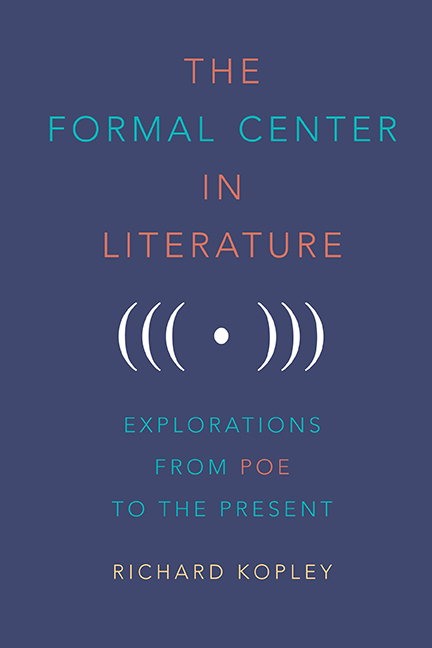Book contents
- Frontmatter
- Dedication
- Contents
- Acknowledgments
- Introduction
- 1 “Mournful and Never-Ending Remembrance” in Edgar Allan Poe's The Narrative of Arthur Gordon Pym
- 2 Retracing Our Steps in Edgar Allan Poe's “The Man of the Crowd”
- 3 “Scrutinizing the Parchment More Closely”: The Form of “The Gold-Bug” and Its Relationship to That of the Dupin Tales
- 4 Form and Reform in Nathaniel Hawthorne's “Earth's Holocaust”
- 5 The Circle and Its Center in Herman Melville's “Bartleby, the Scrivener”
- 6 Chiasmus in Henry David Thoreau's Walden
- 7 The Mythological Centers of Lewis Carroll's Alice Books
- 8 Table as Text in James Joyce's “The Dead”
- 9 The Structure of Sherwood Anderson's “Hands”
- 10 The Architecture of Ernest Hemingway's “The Three-Day Blow”
- 11 Balance in Dashiell Hammett's The Maltese Falcon
- 12 Framing Caesar in Raymond Chandler's The Big Sleep
- 13 The Ridge of the Domino in Patricia Highsmith's Strangers on a Train
- 14 The “X in the Air” in Joyce Carol Oates's “Where Are You Going, Where Have You Been?”
- 15 The Hybrid Center of Zadie Smith's White Teeth
- Notes
- Bibliography
- Index
3 - “Scrutinizing the Parchment More Closely”: The Form of “The Gold-Bug” and Its Relationship to That of the Dupin Tales
Published online by Cambridge University Press: 14 June 2019
- Frontmatter
- Dedication
- Contents
- Acknowledgments
- Introduction
- 1 “Mournful and Never-Ending Remembrance” in Edgar Allan Poe's The Narrative of Arthur Gordon Pym
- 2 Retracing Our Steps in Edgar Allan Poe's “The Man of the Crowd”
- 3 “Scrutinizing the Parchment More Closely”: The Form of “The Gold-Bug” and Its Relationship to That of the Dupin Tales
- 4 Form and Reform in Nathaniel Hawthorne's “Earth's Holocaust”
- 5 The Circle and Its Center in Herman Melville's “Bartleby, the Scrivener”
- 6 Chiasmus in Henry David Thoreau's Walden
- 7 The Mythological Centers of Lewis Carroll's Alice Books
- 8 Table as Text in James Joyce's “The Dead”
- 9 The Structure of Sherwood Anderson's “Hands”
- 10 The Architecture of Ernest Hemingway's “The Three-Day Blow”
- 11 Balance in Dashiell Hammett's The Maltese Falcon
- 12 Framing Caesar in Raymond Chandler's The Big Sleep
- 13 The Ridge of the Domino in Patricia Highsmith's Strangers on a Train
- 14 The “X in the Air” in Joyce Carol Oates's “Where Are You Going, Where Have You Been?”
- 15 The Hybrid Center of Zadie Smith's White Teeth
- Notes
- Bibliography
- Index
Summary
The letter X will never disappear. The more you cross it out, the more it's here. But if it vanished, treasure maps would not Have anything with which to mark the spot, And treasure isles would ring with the despair Of puzzled pirates digging everywhere.
—Richard Wilbur, “The Disappearing Alphabet”
IF WE CONSIDER Edgar Allan Poe's “The Gold-Bug” (1843) and his three Dupin tales—“The Murders in the Rue Morgue” (1841), “The Mystery of Marie Rogêt” (1843–44), and “The Purloined Letter” (1845)—we may readily focus on Legrand and his friend versus Dupin and his friend, or the American setting versus the Parisian one. Clearly for a tale about Captain Kidd and an English-language puzzle, an American setting was necessary. And perhaps, as J. Gerald Kennedy has suggested, “The Gold-Bug” is the turning point in Edgar Allan Poe's career—that is, the point at which Poe began to focus primarily on American locales rather than foreign ones. But it may be interesting to consider formal matters—the turning point of that turning point, the midpoint, the center of “The Gold-Bug”—in relation to the centers of the Dupin tales.
Poe wrote in Eureka (1848) that “the sense of the symmetrical is the poetical essence of the Universe,” and we have already seen that symmetry is often a structuring principle of his fiction. Further evidence to be adduced here suggests that “The Gold-Bug” features the framed central chiasmus of “Rue Morgue” and “Marie Rogêt” and anticipates the framed central shift and the formally significant nearpalindrome of the coming “Purloined Letter.” In other words, “The Gold-Bug” shows Poe experimenting with form for a ratiocinative tale, drawing elements from an earlier design and working through elements of a later one, even as he always maintained his controlling symmetry.
In the case of “Rue Morgue,” symmetrical phrasing frames a chiastic center, the verbal pattern ABBA, yielding the X. Poe played with this trope in a chiastic sentence in his jeu d'esprit, “X-ing a Paragrab”: “X, everybody knew, was an unknown quantity; but in this case … there was an unknown quantity of X” (M 3:1375). If “X” is A and “unknown quantity” is B, then we have the pattern ABBA, the chiastic crisscross.
- Type
- Chapter
- Information
- The Formal Center in LiteratureExplorations from Poe to the Present, pp. 28 - 34Publisher: Boydell & BrewerPrint publication year: 2018

